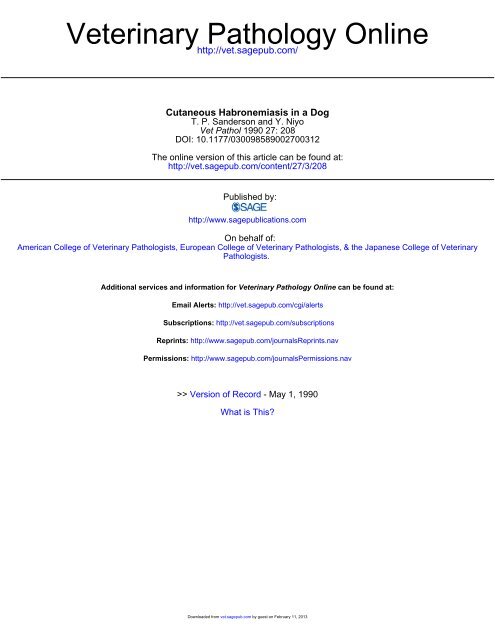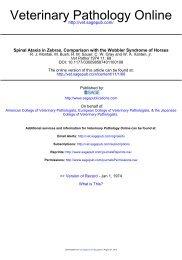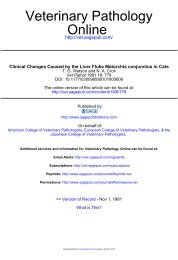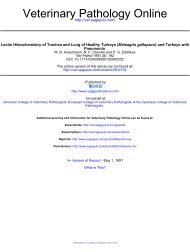Cutaneous Habronemiasis in a Dog - Veterinary Pathology
Cutaneous Habronemiasis in a Dog - Veterinary Pathology
Cutaneous Habronemiasis in a Dog - Veterinary Pathology
You also want an ePaper? Increase the reach of your titles
YUMPU automatically turns print PDFs into web optimized ePapers that Google loves.
Veter<strong>in</strong>ary <strong>Pathology</strong> Onl<strong>in</strong>e<br />
http://vet.sagepub.com/<br />
<strong>Cutaneous</strong> <strong>Habronemiasis</strong> <strong>in</strong> a <strong>Dog</strong><br />
T. P. Sanderson and Y. Niyo<br />
Vet Pathol 1990 27: 208<br />
DOI: 10.1177/030098589002700312<br />
The onl<strong>in</strong>e version of this article can be found at:<br />
http://vet.sagepub.com/content/27/3/208<br />
Published by:<br />
http://www.sagepublications.com<br />
On behalf of:<br />
American College of Veter<strong>in</strong>ary Pathologists, European College of Veter<strong>in</strong>ary Pathologists, & the Japanese College of Veter<strong>in</strong>ary<br />
Pathologists.<br />
Additional services and <strong>in</strong>formation for Veter<strong>in</strong>ary <strong>Pathology</strong> Onl<strong>in</strong>e can be found at:<br />
Email Alerts: http://vet.sagepub.com/cgi/alerts<br />
Subscriptions: http://vet.sagepub.com/subscriptions<br />
Repr<strong>in</strong>ts: http://www.sagepub.com/journalsRepr<strong>in</strong>ts.nav<br />
Permissions: http://www.sagepub.com/journalsPermissions.nav<br />
>> Version of Record - May 1, 1990<br />
What is This?<br />
Downloaded from<br />
vet.sagepub.com by guest on February 11, 2013
Vet. Pathol. 27:208-209 (1990)<br />
Key words: <strong>Dog</strong>; habronemiasis; parasite; sk<strong>in</strong>.<br />
<strong>Cutaneous</strong> <strong>Habronemiasis</strong> <strong>in</strong> a <strong>Dog</strong><br />
<strong>Cutaneous</strong> habronemiasis (summer sores), a common condition<br />
<strong>in</strong> horses, is characterized by ulcerative, non-heal<strong>in</strong>g<br />
sk<strong>in</strong> lesions and the formation of exuberant granulation tis-<br />
~ue.~.6.~.9 It is caused by aberrant <strong>in</strong>tradermal migration by<br />
third-stage larvae (juveniles) of equ<strong>in</strong>e spiruroid stomach<br />
worms, Habronema musca, Habronema microstoma, and<br />
Draschia megastoma. 1,4,6~10 The normal life cycle of these<br />
nematodes <strong>in</strong>volves development <strong>in</strong>to the <strong>in</strong>fective thirdstage<br />
larvae <strong>in</strong> a muscid <strong>in</strong>termediate host.4 Infective larvae<br />
are deposited by the adult fly on the mouth and lips of horses<br />
and are then swallowed and mature to adults <strong>in</strong> the stomach.<br />
<strong>Cutaneous</strong> <strong>in</strong>fections occur when <strong>in</strong>fective larvae are deposited<br />
by flies feed<strong>in</strong>g <strong>in</strong> moist areas or open wounds <strong>in</strong>stead<br />
of the mouth and lips. Experimentally, it has been demonstrated<br />
that <strong>in</strong>fective larvae can penetrate normal, <strong>in</strong>tact sk<strong>in</strong>.4<br />
Areas frequently <strong>in</strong>volved <strong>in</strong>clude the lower limbs, medial<br />
canthus of the eye, the urethral process, and prepuce.’ There<br />
are no previous reports of this condition <strong>in</strong> other species.<br />
T. P. SANDERSON AND Y. NIYO<br />
This report describes a case of cutaneous habronemiasis <strong>in</strong><br />
a dog.<br />
In early July, a 9-year-old, spayed female, mixed-breed<br />
dog was exam<strong>in</strong>ed because of a large, ulcerated lesion on the<br />
face. This lesion started as a small swell<strong>in</strong>g lateral to the right<br />
naris. Dur<strong>in</strong>g the follow<strong>in</strong>g 2 weeks, the lesion ulcerated and<br />
spread to <strong>in</strong>volve most of the right side of the nose and face<br />
rostra1 to the medial canthus of the right eye. A biopsy from<br />
the edge of the lesion was fixed <strong>in</strong> 10% neutral buffered for-<br />
mal<strong>in</strong> and submitted for histopathologic evaluation.<br />
Histologically, the epidermis was ulcerated and overlaid<br />
with a th<strong>in</strong> layer of necrotic cellular debris admixed with<br />
neutrophils. The dermis and subcutis were markedly edem-<br />
atous and conta<strong>in</strong>ed extensive <strong>in</strong>filtrates of <strong>in</strong>flammatory<br />
cells, predom<strong>in</strong>antly eos<strong>in</strong>ophils, with fewer plasma cells,<br />
macrophages, and lymphocytes. Variably-sized tracts of ne-<br />
crotic cellular debris admixed with fragmented collagen and<br />
large numbers of degenerate eos<strong>in</strong>ophils were also present <strong>in</strong><br />
Fig. 1. Dermis, dog. Note that necrotic tracts conta<strong>in</strong> transverse and oblique sections of nematode larvae. HE. Bar =<br />
50 pm.<br />
Fig. 2. Dermis, dog. Transverse section. Note the shrunken degenerate nematode larva with a dist<strong>in</strong>ct gut and the <strong>in</strong>tense<br />
eos<strong>in</strong>ophilic <strong>in</strong>flammatory <strong>in</strong>filtrate. HE. Bar = 20 pm.<br />
Fig. 3. Dermis, necrotic tract, dog. The tract conta<strong>in</strong>s a transverse section of a nematode larva depicted <strong>in</strong> Fig. 1. Note<br />
the maximum diameter 41 pm, prom<strong>in</strong>ent longitud<strong>in</strong>al cuticular ridges (arrowheads), and a dist<strong>in</strong>ct gut. HE. Bar = 20 pm.<br />
208<br />
Downloaded from<br />
vet.sagepub.com by guest on February 11, 2013
the dermis. Transverse, oblique, and longitud<strong>in</strong>al sections of<br />
nematode larvae <strong>in</strong> various stages of degeneration were present<br />
<strong>in</strong> the centers of several of these tracts (Figs. 1, 2). The<br />
maximum diameter of transverse sections of these nematodes<br />
ranged from 38 to 43 pm. Their cuticles were th<strong>in</strong> (1-<br />
2 pm) with 37 to 40 f<strong>in</strong>e longitud<strong>in</strong>al cuticular ridges (Fig.<br />
3). Intest<strong>in</strong>al structures were often poorly def<strong>in</strong>ed, but a gut<br />
was apparent <strong>in</strong> some sections (Figs. 2,3). Other microscopic<br />
changes <strong>in</strong>cluded occasional small collections of large macrophages<br />
with abundant pale cytoplasm surround<strong>in</strong>g unidentified<br />
cell debris or accumulations of a homogenous eos<strong>in</strong>ophilic<br />
substance (Splendore-Hoeppli material), multiple<br />
hemorrhages, mild reactive fibroplasia, and atrophy of adnexae.<br />
Based on size, structure, the presence of longitud<strong>in</strong>al cuticular<br />
ridges, and the nature of the lesion, these nematodes<br />
were identified as third-stage larvae of Habronema sp., the<br />
spiruroid stomach worm of the horse. They are similar <strong>in</strong><br />
appearance to the third-stage larva of Habronema muscae. lo<br />
The larva of H. muscae has 40 to 42 cuticular ridges and a<br />
maximum diameter of 41 pm.I0 D. megastoma has a smooth<br />
cuticle and is slightly larger.4.10 The histologic appearance of<br />
the third stage larvae of H. microstoma has not been described<br />
<strong>in</strong> the previous literature.<br />
The cl<strong>in</strong>ical presentation and microscopic lesions of cutaneous<br />
habronemiasis <strong>in</strong> this dog were similar to those seen<br />
<strong>in</strong> horses; however, rapid proliferation of granulation tissue,<br />
a characteristic feature of this condition <strong>in</strong> the horse, was<br />
not present. Cl<strong>in</strong>ically, this condition must be differentiated<br />
from an <strong>in</strong>filtrat<strong>in</strong>g cutaneous neoplasm, particularly squamous<br />
cell carc<strong>in</strong>oma. Differential microscopic diagnoses <strong>in</strong>clude<br />
dermatitis due to other migrat<strong>in</strong>g nematode larvae,<br />
such as Ancylostoma can<strong>in</strong>um or Unc<strong>in</strong>aria stenocephala,<br />
the free-liv<strong>in</strong>g saprophyte Pelodera strongyloides, Strongyloides<br />
stercoralis, and dermatitis associated with microfilariae<br />
of Dirofilaria immitis. All of these nematode larvae are considerably<br />
smaller and morphologically different from those<br />
of Habronema spp.' Can<strong>in</strong>e eos<strong>in</strong>ophilic granuloma should<br />
also be considered if nematodes are not present <strong>in</strong> the lesion.5<br />
Several factors may have contributed to the development<br />
of this condition. This dog was housed under poor sanitary<br />
conditions <strong>in</strong> a small shed with several heavily parasitized<br />
ponies. The near record high temperatures dur<strong>in</strong>g this summer<br />
period may have resulted <strong>in</strong> larger and more active fly<br />
populations. It has been shown that sk<strong>in</strong> temperatures 1-2<br />
C above body temperature stimulate Habronema larvae to<br />
activate and break out of fly mouthparts.8 Possibly this con-<br />
Case Reports 209<br />
dition resulted from an <strong>in</strong>ord<strong>in</strong>ately heavy exposure to <strong>in</strong>-<br />
fective larvae. It has been suggested that the pathogenesis of<br />
this condition <strong>in</strong> the horse may <strong>in</strong>volve a hypersensitivity<br />
to larval antigens.l.2J0<br />
This dog responded to therapy with oral and topical fe-<br />
bendazole (Panacur @, Hoechst-Roussel Agri-Vet Co., Som-<br />
erville, NJ), broad spectrum antibiotics, and corticosteroids.<br />
Resolution was complete with<strong>in</strong> 2 to 3 weeks.<br />
Acknowledgments<br />
The authors thank Dr. J. H. Greve for assistance with<br />
identification of these nematodes and for review<strong>in</strong>g this<br />
manuscript.<br />
References<br />
1 Fadok VA: Parasitic sk<strong>in</strong> diseases of large animals. Vet<br />
Cl<strong>in</strong> North Am [Large Anim Pract] 6:22-24, 1984<br />
2 Kirkland K, Conv<strong>in</strong> RM, Coffman JR: <strong>Habronemiasis</strong><br />
<strong>in</strong> an Arabian stallion. Equ<strong>in</strong>e Pract 3:34-38, 1981<br />
3 Nichols RL The etiology of visceral larval migrans. 11.<br />
Comparative larval morphology of Ascaris lumbricoides,<br />
Necator americanus, Strongyloides stercoralis and Ancylostoma<br />
can<strong>in</strong>um. J Parasitol 42:363-399, 1956<br />
4 Nishiyama S: Studies on habronemiasis <strong>in</strong> horses. Bull<br />
Fac Agr, Kagoshima University 7:l-81, 1958<br />
5 Scott DW: <strong>Cutaneous</strong> eos<strong>in</strong>ophilic granulomas with collagen<br />
degeneration <strong>in</strong> the dog. J Am Anim Hosp Assoc<br />
19~529-532, 1983<br />
Downloaded from<br />
vet.sagepub.com by guest on February 11, 2013<br />
6 Scott DW: Large Animal Dermatology, pp. 251-254.<br />
W. B. Saunders, Philadelphia, PA, 1988<br />
7 Steckel RR, Kazacos KR, Han<strong>in</strong>gton DD, Thacker HL,<br />
Rebar AH: Equ<strong>in</strong>e pulmonary habronemiasis with acute<br />
hemolytic anemia result<strong>in</strong>g from organophosphate treat-<br />
ment. Equ<strong>in</strong>e Pract 535-39, 1983<br />
8 Trees AJ, May SA, Baker JB: Apparent case of equ<strong>in</strong>e<br />
cutaneous habronemiasis. Vet Rec 115: 14-1 5, 1984<br />
9 Vasey JR: Equ<strong>in</strong>e cutaneous habronemiasis. Comp Cont<br />
Educ 323290, 198 1<br />
10 Waddell AH: A survey of Habronema spp. and the iden-<br />
tification of third-stage larvae of Habronema megastoma<br />
and Habronema muscae <strong>in</strong> section. Aust Vet J 4520-<br />
21, 1969<br />
Request repr<strong>in</strong>ts from Dr. T. P. Sanderson, Department of<br />
Veter<strong>in</strong>ary <strong>Pathology</strong>, College of Veter<strong>in</strong>ary Medic<strong>in</strong>e, Iowa<br />
State University, Ames, IA 5001 1 (USA).

















